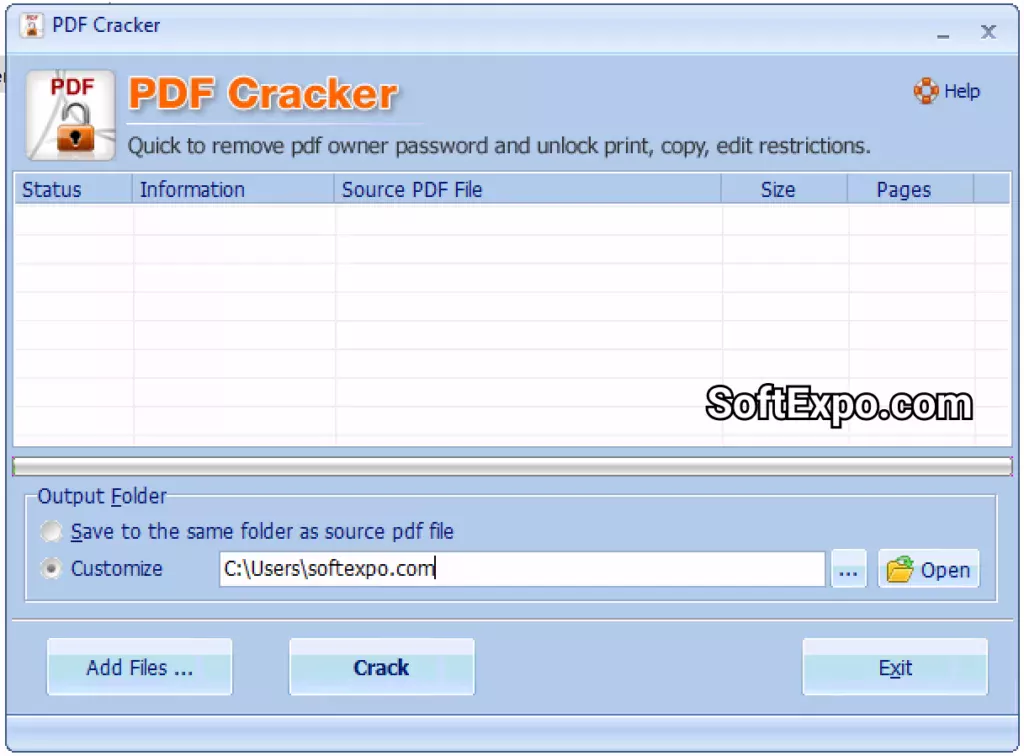All rights reserved © 2025
PDF Cracker is a Windows PDF unlocker tool that strips owner‑level restrictions from secured PDFs so you can print, copy, and edit documents you already have the right to use. Instead of re‑creating locked reports or contracts from scratch, you run this lightweight PDF decryption tool once and get back a fully editable, restriction‑free file. For anyone who regularly receives over‑protected PDFs from clients, colleagues, or legacy systems, it is often faster to decrypt PDF files than to chase a new export.
Owner‑password restriction removal.
PDF Cracker focuses on removing the so‑called owner password from a file, which is what enforces PDF restrictions on printing, copying text, editing content, or adding annotations. Once those restrictions are gone, you can open the unlocked PDF in any reader and work without limits, while the original layout and content stay intact. This makes it a practical PDF password remover when your issue is blocked features, not a forgotten open password.
Support for modern encryption.
The current PDF Cracker engine supports PDF 1.8 files and can handle common encryption methods such as RC4 and AES at 40‑ and 128‑bit strength, which covers a wide range of documents generated by older and newer PDF workflows. In practice that means the software can unlock secured PDFs from many generations of Adobe Acrobat and other PDF creators, as long as they rely on standard security handlers.
No Adobe Acrobat required.
PDF Cracker is a standalone PDF decryption tool, so you do not need a paid Acrobat license or even the free Reader installed to run it. For small offices and freelancers who only occasionally need to unlock PDF restrictions, avoiding the cost and overhead of full Acrobat is a meaningful win.
Simple interface and drag‑and‑drop.
The program is built as a point‑and‑shoot PDF unlocker rather than a full editor: you load one or more PDFs—often via drag‑and‑drop—pick an output path, and start the unlock process. Because the workflow is so focused, non‑technical users can run PDF Cracker without digging through complex menus or security settings.
Clear scope and legal focus.
PDF Cracker is not a full PDF password cracker for forgotten open passwords it is designed to remove owner‑level restrictions from password protected PDF files that you can already open. Best practice is to use it on documents you own or are explicitly allowed to modify, keeping your use aligned with local law and the sender’s policies.

Modern descriptions of PDF Cracker emphasize reliable support for PDF 1.8, extended encryption coverage, and immediate decryption so that unlocked PDFs open everywhere with no extra plugins. This positions the software as a focused alternative to broader PDF unlocker tools that also try to do merging, splitting, or conversion in the same interface.
At the same time, the wider ecosystem has grown: there are now many PDF password remover competitors on the market, from desktop tools to online unlock PDF services, and PDF Cracker’s niche is being a small, local, one‑job utility. If you mainly need to unlock PDF print, copy, and edit restrictions quickly on Windows, that narrow focus is often exactly what you want.
1) Identify the right kind of lock.
Before you reach for any PDF password remover, open the document in a viewer and check whether it asks for a password just to open or only blocks printing and editing. PDF Cracker is intended for the second case—owner‑level restrictions—not deep PDF password recovery on files you cannot open at all.
2) Load your secured PDFs.
Start PDF Cracker, then drag one or more restricted files into the main window or use the file picker to browse to them. Many users treat this as a batch PDF unlocking step, feeding in all the reports or forms that were exported with over‑aggressive security.
3) Choose where the unlocked files go.
Set an output folder so the tool can write unlocked copies without touching your originals, which is standard best practice for any PDF decryption tool. Keeping locked and unlocked versions side by side helps with audits and lets you roll back if policies change later.
4) Run the unlock process.
Start the job and let PDF Cracker decrypt PDF files in the queue, removing owner passwords and clearing restrictions in a few seconds per document on typical hardware. When it finishes, the unlocked PDFs can be opened in any standard viewer with full control over printing, copying, page extraction, and editing.
5) Edit, print, or archive as needed.
Once the unlock password protected PDF step is complete, use your preferred PDF editor or workflow tools to annotate, merge, sign, or archive the now‑open documents. For teams cleaning up legacy archives, this can dramatically streamline downstream tasks like OCR, redaction, or content reuse.